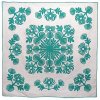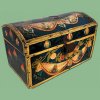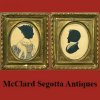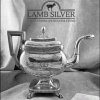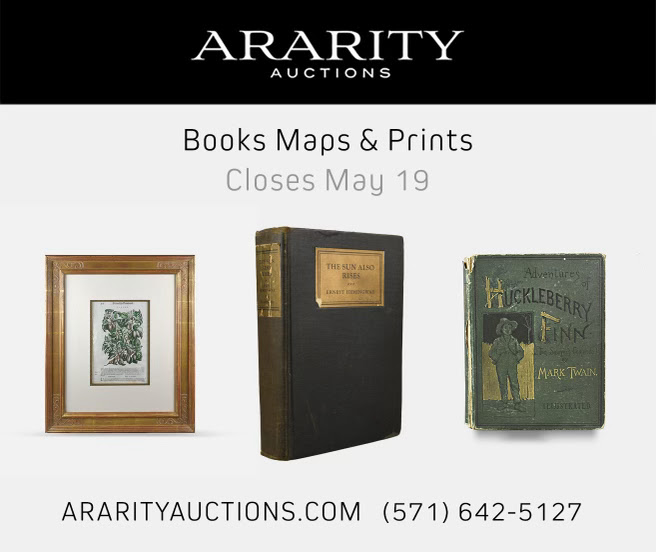Caren Historical Documents Sale
April 11th, 2016
Bonhams, New York City
Photos courtesy Bonhams
“Treasures from the Caren Archive II: How History Unfolds on Paper” was the title of an auction at Bonhams, New York City, on April 11 that again sold documents, letters, and newspapers that tell stories from American history, from the 16th century to the computer age.
This was the fourth offering from the legendary Caren Archive, the largest collection of historical papers in the United States, which still numbers around a million items. There have been two sales at Swann Auction Galleries and two at Bonhams to disperse material from the vast collection formed by Eric Caren, who has been collecting for 50 of his 56 years. Caren sold his first collection of around 30,000 newspapers for $4 million to the Newseum on Pennsylvania Avenue in Washington, D.C., and it forms the nucleus of the museum’s collection. Known as “the Babe Ruth of private historical collecting,” Caren has written books and lectured, founded the Newspaper Collectors’ Society of America, was the director of the Ephemera Society, and is a member of the Grolier Club.
The catalog reads like a syllabus from a graduate history course, with all the original sources annotated. There were broadsides, newspaper articles, letters, cartoons, photographs, scorecards, and advertisements in the sale—327 items, of which 200 sold for a grand total of $850,000; the sale was about 61% sold by lot and 86% by dollar. The last sale at Bonhams brought $1,370,000, thanks in part to the $257,000 (est. $50,000/70,000) paid for the first Boston printing of the Declaration of Independence.
 Caren said he was pleased with his fourth sale and with the way Christina Geiger of Bonhams’ book department worked with him to catalog it, but he was disappointed by Bonhams’ new PR department, which he said failed to produce enough presale publicity. It should have been a good story for magazines and newspapers during the presidential campaigns when the nation is focused on history in the making.
Caren said he was pleased with his fourth sale and with the way Christina Geiger of Bonhams’ book department worked with him to catalog it, but he was disappointed by Bonhams’ new PR department, which he said failed to produce enough presale publicity. It should have been a good story for magazines and newspapers during the presidential campaigns when the nation is focused on history in the making.
“I got an AP story out,” said Caren. “I had to do my own PR.” Somehow some of the right people heard about the sale. Most of the bids came online and on the phones, and more than a dozen collectors and dealers came to the sale to bid in person. There seemed to be plenty of interest in the primary sources of American history. The Broadway play Hamilton may have had an influence on the success of material relating to the Revolution, the Declaration, the Constitution, and Alexander Hamilton. The 18th-century material performed better than earlier material, Civil War material, or anything related to the modern age of politics, sports, celebrities, or computers.

The first secession broadside, “Charleston Mercury Extra...The Union is Dissolved!,” was printed in Charleston, South Carolina, on December 20, 1860, about 15 minutes after the final vote in South Carolina, the first state to secede from the Union. The 555 x 284 mm printed broadside, with pale offsetting, has tiny holes at fold intersections and is in near fine condition. This announcement of the birth of the Confederacy sold online for $35,000 (est. $15,000/25,000).
George Washington’s journal, written after Governor Dinwiddie of Virginia commissioned the 21-year-old major to travel to the Ohio Valley and negotiate with the French to withdraw their forces, was published in the Maryland Gazette in Annapolis by Jonas Green, March 21-28, 1754. It sold online for $173,000 with buyer’s premium (est. $60,000/90,000). Apparently it was first published in England in book form, but this is the earliest procurable American edition of the events that led to the French and Indian War.

These are “Major George Washington’s Journal to the River Ohio, &c.” and “The Conclusion of Major Washington’s Journal, begun in our last,” as printed in the Maryland Gazette, Annapolis, Maryland, by Jonas Green, March 21-28, 1754, numbers 463-464. These two bifolium issues (361 x 240 mm) are bound in modern half calf over marbled boards with a red morocco spine label. Gutter margins have some old staining, recent restoration obscures several letters, and a very few letters are lacking; the second number has a few stains, plus some pen trials. These sold online for $173,000 (est. $60,000/90,000), underbid on the phone.
These are the earliest procurable American editions of this journal by George Washington, a critical document that leads up to the French and Indian War. Washington was 21 at the time of his journey north. He returned to Williamsburg with the news that the French refused to withdraw. This first newspaper printing by Jonas Green was taken from a pamphlet form printed in Williamsburg.
A pocket Bible printed in Edinburgh by Adrian Watkins in 1755 and carried by Francis Merrifield during the Battle of Bunker Hill sold on the phone for $161,000 (est. $50,000/80,000). Isaiah Thomas’s annotated copy of George Washington’s Thanksgiving proclamation sold for $31,250 (est. $30,000/50,000). Washington recommended “Thursday the twenty-sixth day of November next to be devoted to the service of that great and glorious Being, who is the beneficent Author of all the good that was, that is, and that will be….” Thanksgiving did not become a national holiday until Abraham Lincoln made it so during the Civil War.

This “Bunker Hill Bible” owned by Francis Merrifield was printed in Edinburgh by Adrian Watkins in 1755. It is a pocket-size Bible that has a written description of the Battle of Bunker Hill and the number of Merrifield’s gun, 183. It sold on the phone for $161,000 (est. $50,000/80,000). It is 152 x 92 mm and was printed in two columns and bound in contemporary calf. A few leaves are lacking at the ends (including first title) and possibly internally. It has general browning and wear and an abraded binding, the clasps are mostly lacking, and a small piece is missing from the head of the spine. From the ownership inscription, it was owned by Francis Merrifield (1735-1814) of Ipswich, Massachusetts, and went by descent to Elizabeth Merrifield Wade, then Thomas Wade (d. 1827) and William Wade, and then was a gift to Rufus Choate in 1872.
It took several issues to print Alexander Hamilton’s report of public credit in Congress’s hometown paper Gazette of the United States in 1790. Caren called it the foundation of America’s financial system. Hamilton had set forth his plan for strengthening the nation’s credit and increasing the size of the national debt. Twelve continuous-run issues from January 20 through February 26, 1790, sold online for $23,750 (est. $12,000/18,000). No doubt the current Broadway play helped the price.
The survival of both a broadside signed by President Jefferson and Secretary of State Madison and a letter signed by Madison summoning Congress to vote on the Louisiana Purchase is exceptional. That lot sold for $31,250 (est. $25,000/35,000).

This broadside proclamation summons Congress to a vote on the Louisiana Purchase. It is signed in type by President Thomas Jefferson and Secretary of State James Madison. It also came with a letter signed by James Madison. With original folds and in very fine condition the two sheets sold in the salesroom for $31,250 (est. $25,000/35,000). According to Rare Book Hub, in the last 50 years two other copies of James Madison’s circular letter have appeared in the trade, but neither of these had the original enclosure of Jefferson’s handsome and important broadside.
“The most special aspect of collecting historical documents and newspapers is that sense of immediacy, messiness, mistakes, and excitement they offer—understanding what it was like to live in those times,” Caren wrote in the catalog. “Some problems were the same, and some shockingly different. History is written by the victors in books, but real history is shaped by everyone in letters, protest posters, newspapers, and personal records. And, that’s what we have here—‘old news’—it’s very democratic.”
Caren said this was his favorite sale of the four so far. “There were hot-button topics and pieces that made me laugh,” he said. For example, there were two lots about the first two women to run for president of the United States, long before Hillary or women’s suffrage. A satirical mechanical card, 4 7/8" x 2½", together with a political cartoon, concerning the campaign of Belva Lockwood, the second woman to run for president of the United States, in 1884, sold on one bid for $1250 (est. $1500/2500). Lockwood was a prominent women’s rights activist, attorney, and educator who ran for president in 1884 and 1888 as the National Equal Rights candidate.

This satirical mechanical card, 4 7/8" x 2½", 1884, is captioned “Our Next President / Belvia [sic] Lockwood. But Do-n-t Give It Away.” It has light soiling, and possibly the original label has been removed from the back. It features a caricature of Belva Lockwood (1830-1917) in a brown dress that lifts to reveal Benjamin Butler—the 1884 Greenback Party candidate for president—hiding beneath. The meaning of this satire is obscure, but perhaps it makes reference to Butler’s support in Congress of Lockwood’s 1874 petition to allow women to argue before the Supreme Court. It sold with a wood-engraved political cartoon, “New Jersey.—The Humors of the Political Campaign—Parade of the Belva Lockwood Club of the City of Rahway,” (not shown), 233 x 355 mm, an extract from Frank Leslie’s Illustrated Newspaper on November 1, 1881, pages 169-170. The lot brought $1250 (est. $1500/2500). Caren thought it should have brought more because these two pieces of memorabilia were from the 1884 presidential campaign of only the second woman to run for president. Lockwood, a prominent women’s rights activist, attorney, and educator, ran for president in 1884 and 1888 as the National Equal Rights Party candidate. Bonhams photo. Bonhams, New York City, April11, 2016.
If Lockwood was the second woman to run for president of the United States, who was the first? Victoria C. Woodhull was nominated by the Equal Rights Party in 1872 with Frederick Douglass as her running mate. She ran again in 1892. A broadside dated 1893 together with an issue of Woodhull & Claflin’s Weekly, January 17, 1874, sold for $3125 (est. $1200/1800).

This campaign poster for the first woman presidential candidate, “Victoria C. Woodhull, Candidate for the Presidency of the United States—1893,” a 703 x 261 mm broadside with text in three columns, has faint wrinkling, two small holes at the top not affecting the text, and a tiny tear in the first column with no loss of text. It was offered with an issue of Woodhull & Claflin’s Weekly, New York, January 17, 1874, and sold online for $3125 (est. $1200/1800). This very rare campaign poster predated women’s right to vote and announced the intent of women’s rights advocate and suffragette Victoria Claflin Woodhull (1838-1927) to enter the presidential campaign of 1892. Woodhull had become the first woman presidential candidate in 1872 when she was nominated by the Equal Rights Party, with Frederick Douglass as her running mate. The poster is rare; the auction house could find no examples at auction or in the Online Computer Library Center.
After the sale Caren said if he could have bought back one lot it would have been the earliest procurable printed piece of African Americana, a copy of the “Acts & Laws passed by the Great and General Court or Assembly…of the Massachusetts Bay in New England,” printed by B. Green and J. Allen in 1703. It restricted the manumitting of slaves without posting “fifty pounds to secure and indemnify the town or place…in case he or she by sickness, lameness or otherwise be rendered incapable to support him or herself.” It sold on the phone for $3125 (est. $2500/3500).
There will be more Caren sales in the future but apparently not at Bonhams. “If I had been treated better by the PR department, I would have liked to have stayed. The book staff was wonderful to work with, but I’m already in talks with Swann for my next sale,” said Caren after the sale. “My earlier differences with Swann have been resolved.”
In the meantime Caren will be hunting for significant paper everywhere, at trade shows, estates sales, flea markets, antiques shops, rare books and ephemera dealers, military shows, photography fairs, sports memorabilia shows, gun shows, from collectors, and at auctions. “I love to hold history in my hand. I love the hunt, and I find that rare book dealers offer a lot more paper now than ever before. They are aware that once they sell it, it’s hard to replace.
The pictures and captions show some of the highlights from the fourth Caren sale. For more information, go to (www.bonhams.com).

The first Connecticut printing of the Constitution in the New-Haven Gazette and the Connecticut Magazine, published inNew Haven by Josiah Meigs on September 27, 1787, sold on the phone for $19,375 (est. $12,000/18,000). It has a small marginal hole in the gutter,
even toning, and some minor stains but is overall in
excellent condition.

This is a copy of Washington’s Thanksgiving proclamation as printed in the Gazette of the United States,published by John Fenno, New York, on October 7, 1789. It has a little smudging and a small loss to the lower right corner of the second leaf that does not affect the text. It is in excellent condition. This was Isaiah Thomas’s copy and has his annotations. His name is written in the top margin. Thomas (1749-1831) was a publisher and author. The proclamation sold for $31,250 (est. $30,000/50,000).
George Washington issued the Thanksgiving proclamation on October 3, 1789, and set aside a national day of prayer and thanks for the establishment of the United States’ Constitution for that year. The day did not become an annual federal holiday until Abraham Lincoln made it so during the Civil War. This newspaper is dated just four days after the proclamation in the quasi-official federalist newspaper.

Newsprint was scarce in the Confederacy. This copy of the Southern Sentinel was printed on the reverse of beige and white floral wallpaper, with the text in seven columns. Volume one, number 11, was printed in Alexandria, Louisiana, by T.G. Compton on June 20, 1863. There is a signature of the owner in red ink at the four corners. It has a few small holes at old folds and edge wear. It sold for $2750 (est. $1200/1800). Faced with a paper shortage in the South during the war, several papers resorted to printing on wallpaper, wrapping paper, writing paper, paper bags, etc. Another Confederate newspaper (not shown) printed in Natchitoches, Louisiana, the Natchitoches Union Daily, dated April 4, 1864, illustrating the Lincoln-Johnson ballot, sold for the same price.

Twelve issues (one shown), a continuous run of the Gazette of the United States, ten with Alexander Hamilton’s report of public credit, were published by John Fenno from January 20 to February 26, 1790. The report was Hamilton’s plan to strengthen the nation’s credit and increase the nation’s debt. It was a very controversial plan, and the divisions it caused laid the groundwork for the two-party system. The plan did not pass the first time through Congress, but it did pass two weeks later with some compromises, such as the permanent capital being relocated from Philadelphia to along the Potomac River. The copies have some expert repairs to the binding holes. They have even toning, some mild foxing (mostly to later issues), and there are a couple of tears but overall are in excellent condition. They sold online for $23,750 (est. $12,000/18,000).
Originally published in the June 2016 issue of Maine Antique Digest. © 2016 Maine Antique Digest











